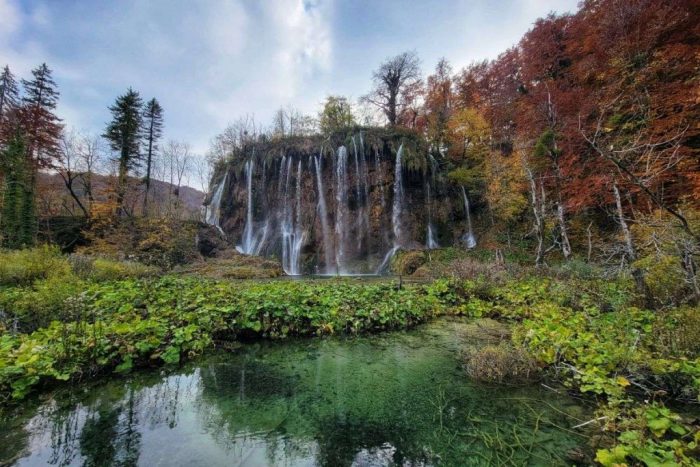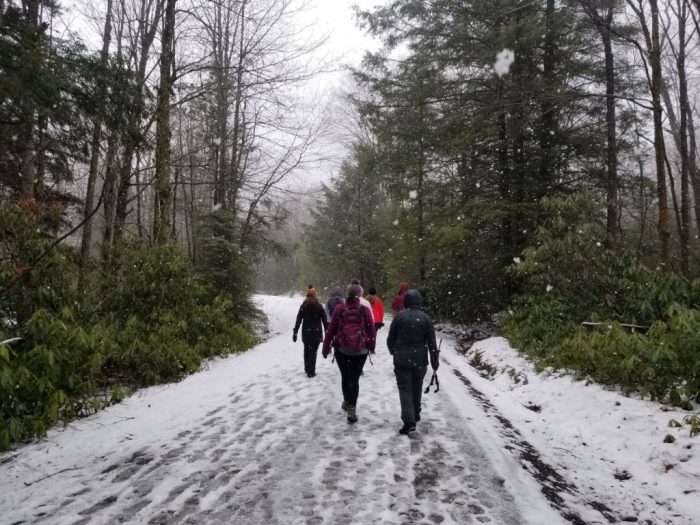How to Symbolically Adopt a Gorilla to Support Wildlife Conservation
Calling all animal lovers! Well, actually, PSA to anyone with an outdoorsy soul: mountain gorillas desperately need our help. These mighty apes are a highly endangered species that have been facing extinction for decades — and conservation efforts are what’s kept them around.
Habitat destruction, poaching, civil unrest, and disease threaten these great primates. If we lose them, we also lose the biodiversity of their forested habitat, which plays a critical role in fighting climate change. Without gorillas, the whole ecosystem gets thrown out of whack. And so do the surrounding communities.
But it’s not all doomed. Keep reading to learn all about the incredible species, the inspiring organizations working tirelessly to protect them, and how you can help save the gorillas.
Facts About Mountain Gorillas
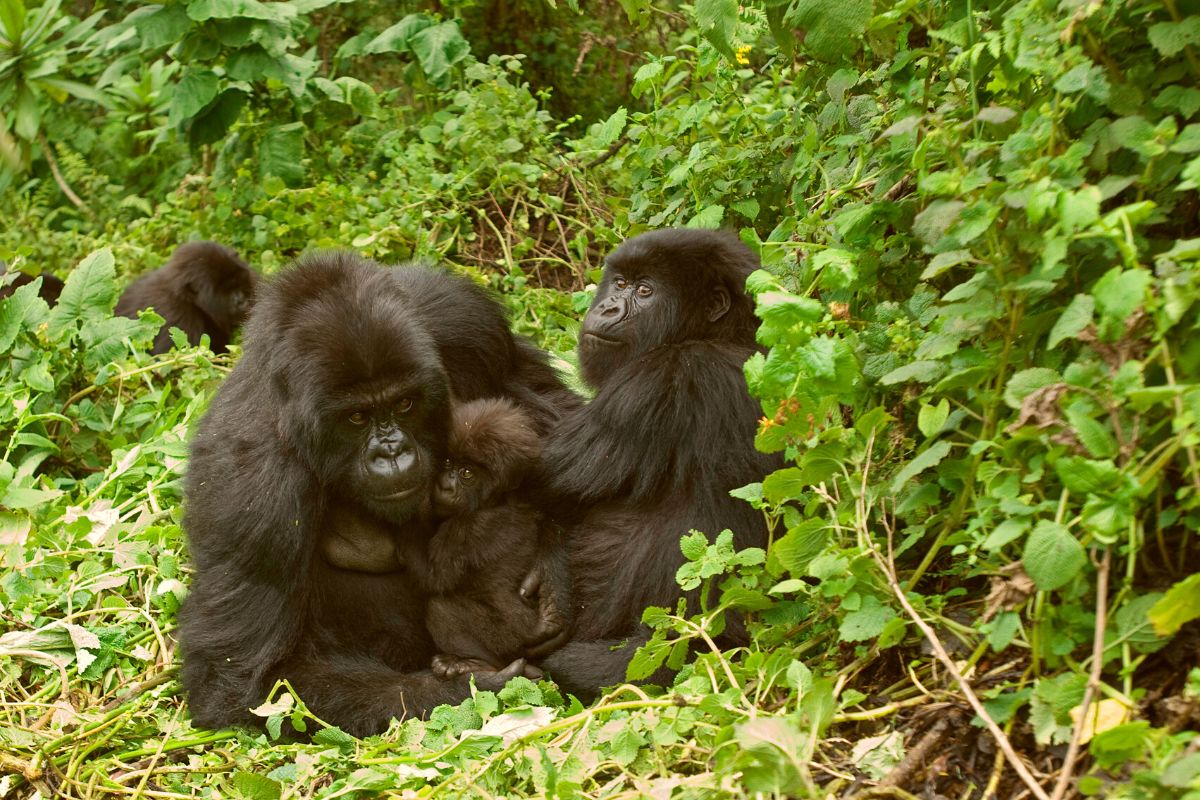
I just took a DNA test, turns out I’m…98% mountain gorilla? (Or whatever Lizzo said.) It’s true! Although there are tons of traits that separate humans from gorilla families, we’re much more alike than we are different. Knowledge is a powerful conservation tool, so here are some quick facts about our primate cousins:
- Gorillas eat about 50 pounds of food every day
- They cry, laugh, grieve, and experience other “human” emotions like sadness, empathy, and curiosity.
- Gorillas are extremely social and loyal to their family groups
- Wild gorillas are highly innovative creatures, sometimes making and using tools
- They live up to 53 years in their natural habitat
- Mountain gorillas are highly vulnerable to diseases transmitted by humans because we’re so closely related
Are Gorillas Endangered?

Protecting gorillas is at the very top of any conservationist’s to-do list. Today, all gorilla subspecies are critically endangered and facing extinction if conservation efforts don’t continue. But with civil unrest, weak wildlife law enforcement, and corruption in the three countries where mountain gorillas live, this threatened species requires urgent, ongoing action.
💔 Top threats to gorilla habitat 💔
- Expanding human settlement
- Extraction of natural resources
- Human diseases
- Poaching
As similar as people are to mountain gorillas, we’re also their biggest threat. Expanding human settlement and (sometimes illegal) extraction of natural resources in the mountain gorilla range has caused immense habitat loss for these great apes. Meanwhile, the precious mountain gorilla population is vulnerable to even the mildest human diseases.
And let’s not forget about poaching. Even though there isn’t a big market for gorilla bushmeat, snares set to catch other animals often injure them. Mountain gorilla infants also have a target regarding animal trafficking, being sold to zoos, researchers, or in the illegal pet trade. Sad enough as it is, at least one adult group member often dies during the abduction, stopping at nothing to save their young.
Mountain gorilla conservation originated back in 1979 when populations were worryingly low. Since then, a coalition of three organizations united, forming what’s now known as the International Gorilla Conservation Programme. They went to work patrolling parks where mountain gorillas live, established gorilla tourism that supports local communities, and spread awareness about gorilla conservation across the world.
In the past 40 years, the International Gorilla Conservation Programme established operations in Rwanda, Uganda, and the Democratic Republic of Congo, including Volcanoes National Park, Bwindi Impenetrable National Park, Mgahinga Gorilla National Park, and Virunga National Park. Their work has helped nearly triple mountain gorilla populations, which continue trending upwards.
Mountain Gorilla Habitat
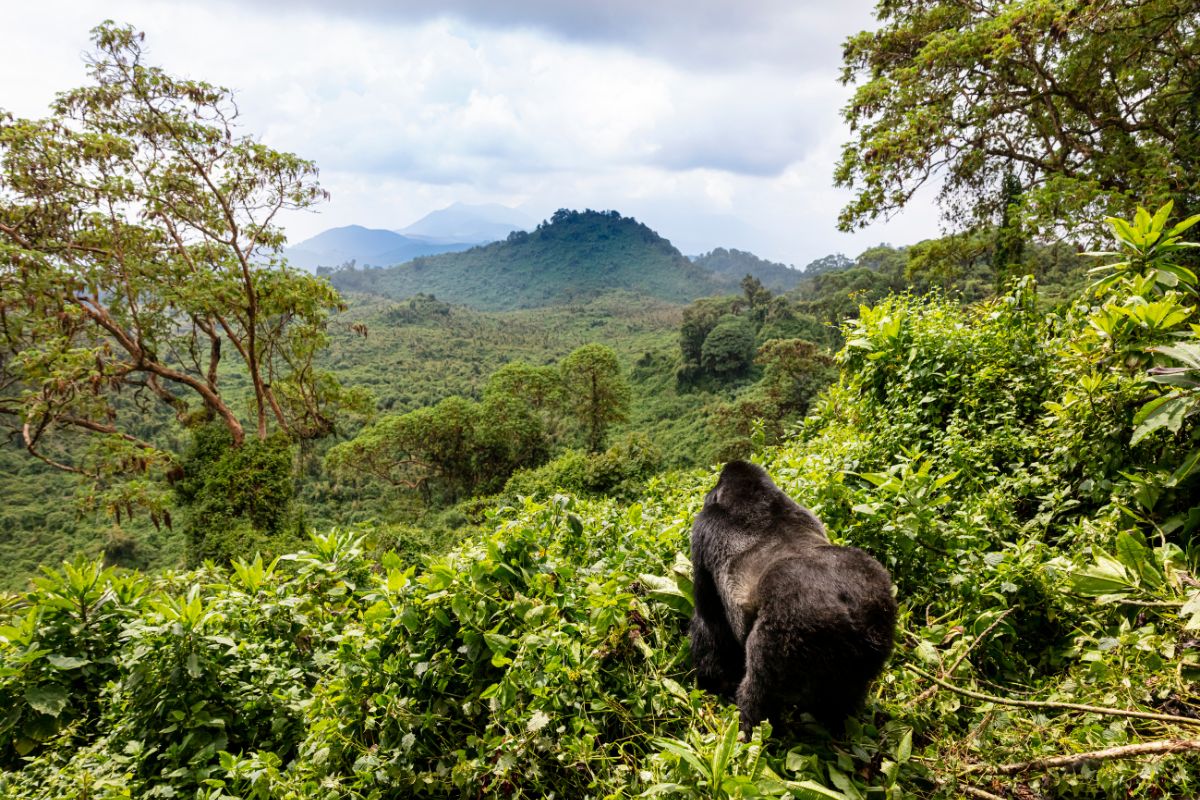
The name doesn’t lie: mountain gorillas live in the mountains! You’ll find these giant primates in their high-altitude homes 8,000 to 13,000 feet above sea level. Of course, temperatures get chilly up in the African forest, but their toasty, insulated fur coats keep ’em nice and cozy.
Mountainous forest makes the perfect habitat for these primarily plant-based eaters. Because these gorillas are herbivores (plus a tiny amount of insects), they migrate throughout the year as bamboo shoots, and other dietary staples become available.
As nomadic animals, this eastern gorilla species is far from territorial. Instead, the dominant male silverback, identifiable by the silver hair on his back, protects their group. He’s the one who calls the shots in the highly social gorilla family. Silverbacks also determine when and where to move when it’s time for the group to travel.
- Mountain Gorillas In Rwanda. Twelve fully habituated families currently live in Rwanda’s Volcanoes National Park, thriving in this inactive volcano region of the Virunga Mountains. This group wanders these protected areas spanning the Rwanda, Uganda, and the Democratic Republic of Congo borders.
- Mountain Gorillas In Uganda. Uganda’s exceptionally diverse Bwindi Impenetrable National Park homes around 340 mountain gorillas. Thick, dense tree growth and high elevation make Bwindi Impenetrable Forest a gorilla haven.
Types of Mountain Gorillas
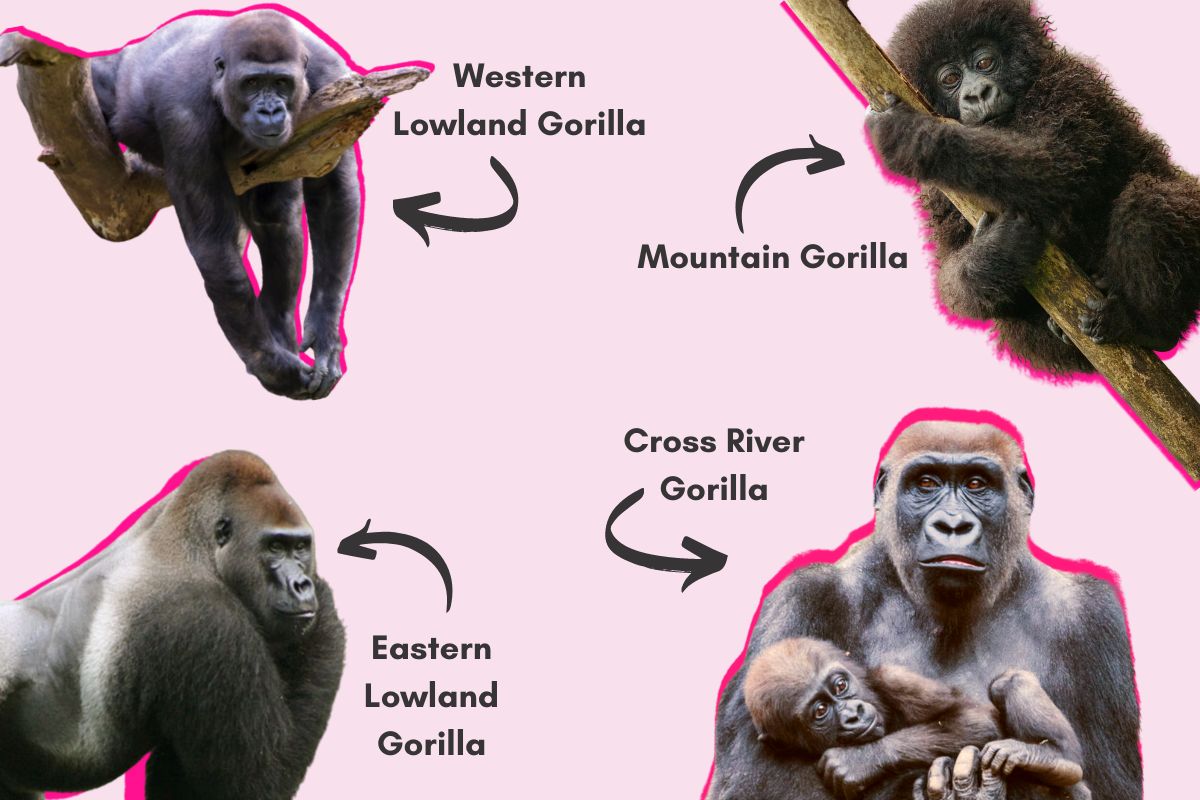
Mountain gorillas aren’t the only primates who call Africa home. Far from that, actually. Primate specialists at the International Union for Conservation of Nature report that 216 monkey species exist on this continent. Visit African national parks, and you’ll surely spot various chimpanzee, baboon, or colobus species — to name a few.
Plus, the almighty gorillas, duh!
Gorillas are mainly split into two categories: eastern and western. But each contains two subspecies, meaning four different types of great apes make up the African gorilla population!
- Western Lowland Gorilla. The widespread Western Lowland gorilla families create a home in the western or central Africa lowland forests yet are sadly the most likely subspecies to live in captivity. Their exact population is unknown, but with an estimated 350,000 remaining in the wild, these critically endangered animals are the most populous type of wild gorillas. Learn more about Western lowland gorilla conservation.
- Cross River Gorilla. Unlike other western gorilla subspecies, the tiny population of Cross River gorilla exclusively inhabits a mere 3,000 square mile region between Cameroon and Nigeria. Continuous human encroachment has made the species more aggressive and difficult to study, but with less than 300 individuals remaining in the wild, the Cross River Gorilla is critically endangered and faces an extremely high risk of extinction. Learn more about Cross River gorilla conservation.
- Eastern Lowland Gorilla. The entire 7,500 Eastern lowland gorilla population, AKA Grauer’s gorilla, exclusively lives in the Congo wilderness. Due to habitat destruction, the Grauer’s gorillas’ home range is only 1/15th what it was 20 years ago, deeply threatening this critically endangered species. Learn more about Eastern lowland gorilla conservation.
- Mountain Gorilla. More than 1,000 wild mountain gorillas exist today, and despite this seemingly low population, it’s a significant improvement from the critically endangered species’ lowest dip of 242 individuals. You can spot majestic mountain gorillas in the high elevations of Volcanoes National Park, Mgahinga Gorilla National Park, Bwindi Impenetrable Forest, or the Virunga Mountains. Learn more about mountain gorilla conservation.
Gorilla Conservation And How to Adopt a Gorilla

Conservation work is necessary to protect threatened wildlife species. And as we know, the gorillas desperately need our help. Boosting ranger based monitoring, preserving habitat from human populations, and collaborating with local people on eco tourism are just a few conservation efforts that protect mountain gorillas.
Luckily, some incredible organizations are doing precisely that. But charitable work doesn’t come cheap. So what can you do? Donate or symbolically adopt a gorilla from one of these dedicated nonprofits to aid the fight for great ape conservation.
Dian Fossey Gorilla Fund
- What they do: The Dian Fossey Gorilla Fund collaborates with local people, governments, and researchers to protect wild mountain and Grauer’s gorillas from poaching, habitat loss, and other illegal activities in Rwanda and Congo.
- Location: 800 Cherokee Avenue, SE, Atlanta, GA 30315
- Qualifications: Dian Fossey Gorilla Fund International is a 501(c)(3) nonprofit organization. View their annual financial reports and leadership team here.
Founded by world-renowned primatologist Dian Fossey, this organization has protected, researched, and spread education about gorillas for over 50 years. But it’s not just about gorillas. Using a holistic approach to conservation, the Fossey Fund also prioritizes the well-being of communities near gorilla habitats, helping all beings thrive.
Anti-poaching teams, trackers, and researchers at the Fossey Fund support nearly half of the mountain gorillas in Rwanda. Have you heard of Ellen DeGeneres’s gorilla conservation campus? It’s here! Meanwhile, the Fossey Fund also protects
Grauer’s gorillas in Congo, hoping to double their elusive population in the next few years.
Symbolically adopt a gorilla through the Fossey Fund to support necessary conservation efforts of these wild animals. Or, get involved by hosting a fundraiser, gifting supplies from their Amazon WishList, or visiting the gorillas.
World Wildlife Fund
- What they do: The World Wildlife Fund protects western lowland gorillas by developing eco tourism, investing in public health, and promoting sustainable development.
- Location: 1250 24th Street, N.W., Washington, DC 20037
- Qualifications: The WWF is a 501(c)(3) nonprofit, tax-exempt organization that meets the BBB Wise Giving Alliance’s standards for charity accountability. View their recent financial reports and leadership team here.
The World Wildlife Fund has been leading global conservation for over 60 years. Their work focuses on six pillars: climate, food, forests, freshwater, oceans, and wildlife. WWF’s comprehensive approach is made powerful through collaboration with expert researchers, scientists, communities, companies, and governments.
WWF supports every gorilla subspecies by implementing diverse protections. These include expanding protected regions, promoting sustainable management of natural resources, investing in gorilla research, partnering with local people, and so much more.
To get involved with WWF’s primate work, symbolically adopt a gorilla, travel with WWF, or join WWF’s action team.
The Gorilla Organization
- What they do: Founded by Dian Fossey, the Gorilla Organization’s unique conservation efforts prioritize anti-poaching methods, boosting sustainable economic opportunities, and spreading education.
- Location: 110 Gloucester Avenue, London NW1 8HX, UK
- Qualifications: The Gorilla Organization is a UK-registered charity approved by the Fundraising Standards Board. View their leadership board here.
TGO prioritizes people near gorilla regions, empowering them with skills and funding to bring organic farming and sustainable electricity to their communities instead of relying on forested resources. They also train folks on gorilla-friendly beekeeping, tree planting, and child-focused conservation education.
The Gorilla Organization’s Stop the Snares Project also reduced traps in south Bwindi Impenetrable National Park to nearly zero, protecting mountain gorillas from poachers. Meanwhile, they’ve planted over 2 million trees along Kahuzi-Biega National Park, home to Grauer’s gorillas, and have already seen wildlife return.
Support TGO’s work by symbolically adopting a mountain gorilla, volunteering, or creating your own fundraising initiative.
Ready to get up close and personal with gorillas?
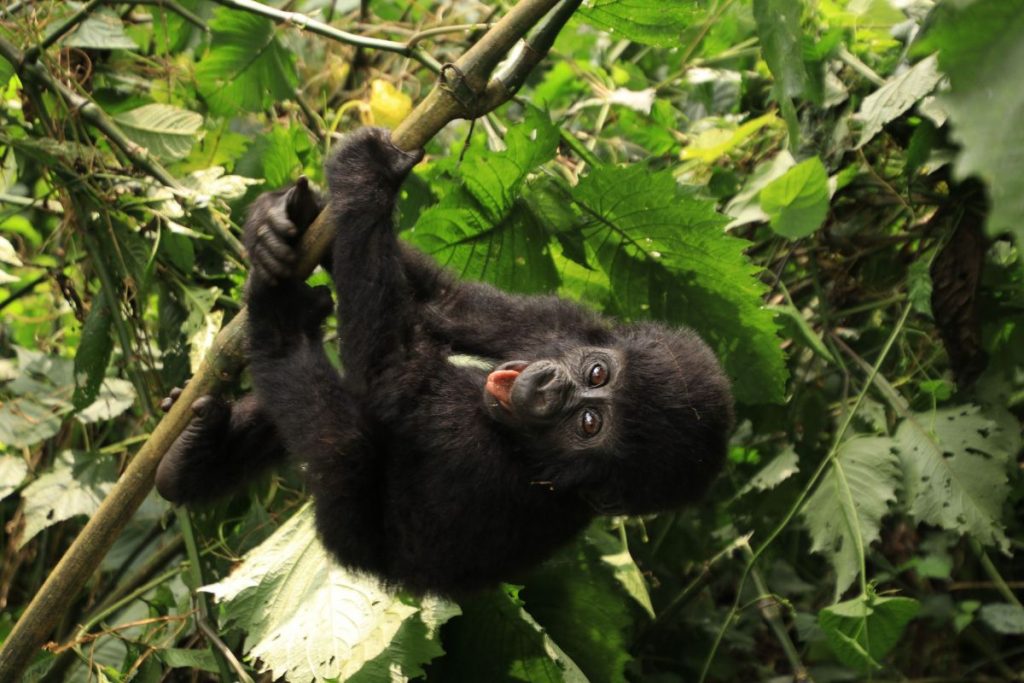
Change your life forever by joining Explorer Chick’s unforgettable mountain gorilla trekking trip to Uganda! Join our group of rad, animal-loving gals on a seriously spectacular journey through the African wilderness. This ain’t no trip to the zoo! Book your Uganda safari today.
Meet the Writer

Megan Wray
Megan Wray is a queer, mixed-race Japanese-Canadian freelance writer based on Treaty 1 Territory. Passionate about pleasure, identity, and anti-oppression, Megan’s fuelled by meaningful chats about topics that aren’t “appropriate” for dinner table conversation. When she’s not writing, you can find Megan cooking vegan food, singing to live music, and trying to understand astrology.
More About Our Favorite International Destinations
- 7 Hot Springs in Uganda That You HAVE to Visit
- Best Castles of Scotland: Must-See Enchanting Castles
- 60th birthday trip ideas for mom
- What You Need To Know Before You Hike Rainbow Mountain Peru
- The Best Cycling Destinations in Croatia
- Best solo trips for women who love adventure
- Your Complete Itinerary of Things to Do in Jordan: An Adventurer’s Guide
- Iceland Insights: Where To See Puffins
- How to Symbolically Adopt a Gorilla to Support Wildlife Conservation



